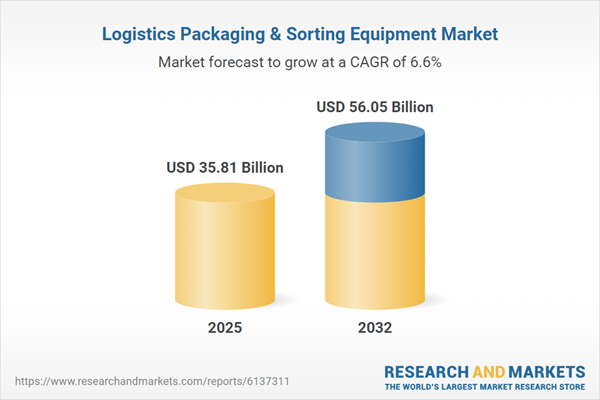Speak directly to the analyst to clarify any post sales queries you may have.
The logistics packaging and sorting equipment market is undergoing significant transformation, driven by rapid advancements in automation, evolving regional demands, and the strategic need for flexible, efficient solutions. Senior decision-makers require current insights to adapt to shifting operational, regulatory, and economic dynamics.
Market Snapshot: Growth Outlook for the Logistics Packaging and Sorting Equipment Market
The logistics packaging and sorting equipment market grew from USD 33.72 billion in 2024 to USD 35.81 billion in 2025. With an expected CAGR of 6.55%, the sector is forecasted to reach USD 56.05 billion by 2032. This upward trajectory is propelled by e-commerce expansion, growing demand for process automation, and the continuous evolution of supply chain models across multiple industries.
Scope & Segmentation: Comprehensive Coverage of Market Dynamics
- Equipment Type: Packaging equipment, sorting equipment, conveyor-based sorting systems, robotic sorting systems.
- Automation Level: Automated and manual solutions span distribution centers and warehouses focused on throughput efficiency or cost optimization.
- Operational Environment: Indoor and outdoor deployments, with requirements shaped by facility type and product handled.
- Application: Bulk/granular products and unitized products, supporting agriculture, manufacturing, and retail supply chains.
- End Use: Agriculture and fresh produce, e-commerce and retail fulfillment, food and beverage, logistics and courier services, manufacturing and industrial, pharmaceuticals and healthcare.
- Distribution Channel: Channel partners and direct sales, facilitating tailored solutions and integrated services.
- Key Regions: Americas (including North America, Latin America), Europe, Middle East & Africa, Asia-Pacific, with detailed focus on developed and emerging logistics hubs.
- Leading Companies: Beumer Group, Ishida Co., Ltd., BÖWE SYSTEC GmbH, Daifuku Co., Ltd., Dematic by KION Group, FIVES Group, KNAPP AG, Krones AG, Marchesini Group, SSI Schaefer, Vanderlande, and more.
Key Takeaways: Strategic Insights for Logistics Equipment Stakeholders
- Automation trends continue to reshape operational models, with robotics and machine vision driving both throughput and accuracy improvements.
- Flexible modular designs and adaptive software are increasingly vital, supporting quick reconfiguration in response to product variety and seasonal shifts.
- Regional dynamics demand tailored approaches, with mature markets embracing predictive analytics while emerging economies prioritize cost-effective retrofit solutions.
- Sustainability initiatives push investments in energy-efficient drives, recyclable materials, and smart maintenance protocols, aligned with environmental compliance mandates.
- Collaboration between equipment manufacturers and software innovators enables holistic supply chain visibility and process optimization.
- Custom solutions and scalable platforms gain importance for industries experiencing SKU proliferation and fluctuating order volumes.
Tariff Impact: Navigating Procurement and Cost Challenges
New United States tariffs in 2025 are influencing equipment procurement strategies, with stakeholders reassessing sourcing models to manage increased costs. Companies are considering local manufacturing for critical modules and extending existing equipment life through retrofits, balancing short-term expenditure with operational efficiency and supply chain continuity.
Methodology & Data Sources: Rigorous Foundations for Strategic Analysis
This research integrates primary interviews with industry leaders, in-depth analysis of technical standards, and secondary data from regulatory and academic sources. Quantitative findings were validated against multiple industry benchmarks, and qualitative insights were synthesized for actionable conclusions.
Why This Report Matters: Guidance for Executive Decision-Makers
- Empowers leadership with a holistic understanding of regional and global trends impacting logistics packaging and sorting equipment adoption.
- Identifies the intersection of innovation, sustainability, and resilience essential for future investments and competitive positioning.
- Supports strategic planning for supply chain diversification, process optimization, and targeted capital allocation within a rapidly evolving market.
Conclusion
As global logistics operations become increasingly complex, senior executives need precise, current intelligence to inform technology investments and strategic direction. This report delivers actionable recommendations for navigating disruption and positioning for sustained growth in logistics packaging and sorting equipment.
Table of Contents
3. Executive Summary
4. Market Overview
7. Cumulative Impact of Artificial Intelligence 2025
Companies Mentioned
The companies profiled in this Logistics Packaging & Sorting Equipment market report include:- Beumer Group
- Ishida Co., Ltd.
- BÖWE SYSTEC GmbH
- Daifuku Co., Ltd.
- Dalian Jialin Machine Manufacture Co., Ltd.
- Dematic by KION Group
- EMBA Machinery by Berg Group
- FIVES Group
- Gosunm Intelligent Industry Co., Ltd.
- IMA Group
- KHS Group by Salzgitter AG Corporation
- KNAPP AG
- Körber AG
- Krones AG
- Marchesini Group
- Mitsubishi Corporation
- MULTIVAC Group
- Murata Machinery, Ltd.
- Mushiny Co.,Ltd.
- Sesotec GmbH
- Shenzhen Empower Supply Chain Technology Co.,Ltd.
- Sidel
- SSI Schaefer Systems International GmbH
- Vanderlande Industries B.V.
- VITRONIC Machine Vision GmbH
Table Information
| Report Attribute | Details |
|---|---|
| No. of Pages | 186 |
| Published | November 2025 |
| Forecast Period | 2025 - 2032 |
| Estimated Market Value ( USD | $ 35.81 Billion |
| Forecasted Market Value ( USD | $ 56.05 Billion |
| Compound Annual Growth Rate | 6.5% |
| Regions Covered | Global |
| No. of Companies Mentioned | 26 |









